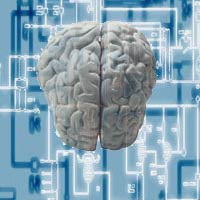Savant for a Day
http://www.nytimes.c...?pagewanted=all

The research of a test in which a research subject was asked to draw a picture of a dog four times, at different stages of his exposure to transcranial magnetic stimulation.
By LAWRENCE OSBORNE
In a concrete basement at the University of Sydney, I sat in a chair waiting to have my brain altered by an electromagnetic pulse. My forehead was connected, by a series of electrodes, to a machine that looked something like an old-fashioned beauty-salon hair dryer and was sunnily described to me as a ''Danish-made transcranial magnetic stimulator.'' This was not just any old Danish-made transcranial magnetic stimulator, however; this was the Medtronic Mag Pro, and it was being operated by Allan Snyder, one of the world's most remarkable scientists of human cognition.
Nonetheless, the anticipation of electricity being beamed into my frontal lobes (and the consent form I had just signed) made me a bit nervous. Snyder found that amusing. ''Oh, relax now!'' he said in the thick local accent he has acquired since moving here from America. ''I've done it on myself a hundred times. This is Australia. Legally, it's far more difficult to damage people in Australia than it is in the United States.''

Hooked up to the Medtronic Mag Pro, a test subject begins the series of tests to show the effect of transcranial magnetic stimulation.
''Damage?'' I groaned.
''You're not going to be damaged,'' he said. ''You're going to be enhanced.''
The Medtronic was originally developed as a tool for brain surgery: by stimulating or slowing down specific regions of the brain, it allowed doctors to monitor the effects of surgery in real time. But it also produced, they noted, strange and unexpected effects on patients' mental functions: one minute they would lose the ability to speak, another minute they would speak easily but would make odd linguistic errors and so on. A number of researchers started to look into the possibilities, but one in particular intrigued Snyder: that people undergoing transcranial magnetic stimulation, or TMS, could suddenly exhibit savant intelligence -- those isolated pockets of geniuslike mental ability that most often appear in autistic people.
Snyder is an impish presence, the very opposite of a venerable professor, let alone an internationally acclaimed scientist. There is a whiff of Woody Allen about him. Did I really want him, I couldn't help thinking, rewiring my hard drive? ''We're not changing your brain physically,'' he assured me. ''You'll only experience differences in your thought processes while you're actually on the machine.'' His assistant made a few final adjustments to the electrodes, and then, as everyone stood back, Snyder flicked the switch.
A series of electromagnetic pulses were being directed into my frontal lobes, but I felt nothing. Snyder instructed me to draw something. ''What would you like to draw?'' he said merrily. ''A cat? You like drawing cats? Cats it is.''
I've seen a million cats in my life, so when I close my eyes, I have no trouble picturing them. But what does a cat really look like, and how do you put it down on paper? I gave it a try but came up with some sort of stick figure, perhaps an insect.
While I drew, Snyder continued his lecture. ''You could call this a creativity-amplifying machine. It's a way of altering our states of mind without taking drugs like mescaline. You can make people see the raw data of the world as it is. As it is actually represented in the unconscious mind of all of us.''
Two minutes after I started the first drawing, I was instructed to try again. After another two minutes, I tried a third cat, and then in due course a fourth. Then the experiment was over, and the electrodes were removed. I looked down at my work. The first felines were boxy and stiffly unconvincing. But after I had been subjected to about 10 minutes of transcranial magnetic stimulation, their tails had grown more vibrant, more nervous; their faces were personable and convincing. They were even beginning to wear clever expressions.
I could hardly recognize them as my own drawings, though I had watched myself render each one, in all its loving detail. Somehow over the course of a very few minutes, and with no additional instruction, I had gone from an incompetent draftsman to a very impressive artist of the feline form.
Snyder looked over my shoulder. ''Well, how about that? Leonardo would be envious.'' Or turning in his grave, I thought.
As remarkable as the cat-drawing lesson was, it was just a hint of Snyder's work and its implications for the study of cognition. He has used TMS dozens of times on university students, measuring its effect on their ability to draw, to proofread and to perform difficult mathematical functions like identifying prime numbers by sight. Hooked up to the machine, 40 percent of test subjects exhibited extraordinary, and newfound, mental skills. That Snyder was able to induce these remarkable feats in a controlled, repeatable experiment is more than just a great party trick; it's a breakthrough that may lead to a revolution in the way we understand the limits of our own intelligence -- and the functioning of the human brain in general.
Snyder's work began with a curiosity about autism. Though there is little consensus about what causes this baffling -- and increasingly common -- disorder, it seems safe to say that autistic people share certain qualities: they tend to be rigid, mechanical and emotionally dissociated. They manifest what autism's great ''discoverer,'' Leo Kanner, called ''an anxiously obsessive desire for the preservation of sameness.'' And they tend to interpret information in a hyperliteral way, using ''a kind of language which does not seem intended to serve interpersonal communication.''
For example, Snyder says, when autistic test subjects came to see him at the university, they would often get lost in the main quad. They might have been there 10 times before, but each time the shadows were in slightly different positions, and the difference overwhelmed their sense of place. ''They can't grasp a general concept equivalent to the word 'quad,''' he explains. ''If it changes appearance even slightly, then they have to start all over again.''
Despite these limitations, a small subset of autistics, known as savants, can also perform superspecialized mental feats. Perhaps the most famous savant was Dustin Hoffman's character in ''Rain Man,'' who could count hundreds of matchsticks at a glance. But the truth has often been even stranger: one celebrated savant in turn-of-the-century Vienna could calculate the day of the week for every date since the birth of Christ. Other savants can speak dozens of languages without formally studying any of them or can reproduce music at the piano after only a single hearing. A savant studied by the English doctor J. Langdon Down in 1887 had memorized every page of Gibbon's ''Decline and Fall of the Roman Empire.'' At the beginning of the 19th century, the splendidly named Gottfried Mind became famous all over Europe for the amazing pictures he drew of cats.
The conventional wisdom has long been that autistics' hyperliteral thought processes were completely separate from the more contextual, nuanced, social way that most adults think, a different mental function altogether. And so, by extension, the extraordinary skills of autistic savants have been regarded as flukes, almost inhuman feats that average minds could never achieve.
Snyder argues that all those assumptions -- about everything from the way autistic savants behave down to the basic brain functions that cause them to do so -- are mistaken. Autistic thought isn't wholly incompatible with ordinary thought, he says; it's just a variation on it, a more extreme example.
He first got the idea after reading ''The Man Who Mistook His Wife for a Hat,'' in which Oliver Sacks explores the link between autism and a very specific kind of brain damage. If neurological impairment is the cause of the autistic's disabilities, Snyder wondered, could it be the cause of their geniuslike abilities, too? By shutting down certain mental functions -- the capacity to think conceptually, categorically, contextually -- did this impairment allow other mental functions to flourish? Could brain damage, in short, actually make you brilliant?
In a 1999 paper called ''Is Integer Arithmetic Fundamental to Mental Processing? The Mind's Secret Arithmetic,'' Snyder and D. John Mitchell considered the example of an autistic infant, whose mind ''is not concept driven. . . . In our view such a mind can tap into lower level details not readily available to introspection by normal individuals.'' These children, they wrote, seem ''to be aware of information in some raw or interim state prior to it being formed into the 'ultimate picture.''' Most astonishing, they went on, ''the mental machinery for performing lightning fast integer arithmetic calculations could be within us all.''
And so Snyder turned to TMS, in an attempt, as he says, ''to enhance the brain by shutting off certain parts of it.''
''In a way, savants are the great enigma of today's neurology,'' says Prof. Joy Hirsch, director of the Functional M.R.I. Research Center at Columbia University. ''They exist in all cultures and are a distinct type. Why? How? We don't know. Yet understanding the savant will help provide insight into the whole neurophysiological underpinning of human behavior. That's why Snyder's ideas are so exciting -- he's asking a really fundamental question, which no one has yet answered.''
If Snyder's suspicions are correct, in fact, and savants have not more brainpower than the rest of us, but less, then it's even possible that everybody starts out life as a savant. Look, for example, at the ease with which children master complex languages -- a mysterious skill that seems to shut off automatically around the age of 12. ''What we're doing is counterintuitive,'' Snyder tells me. ''We're saying that all these genius skills are easy, they're natural. Our brain does them naturally. Like walking. Do you know how difficult walking is? It's much more difficult than drawing!''
To prove his point, he hooks me up to the Medtronic Mag Pro again and asks me to read the following lines:
A bird in the hand
is worth two in the
the bush
''A bird in the hand is worth two in the bush,'' I say.
''Again,'' Snyder says, and smiles.
So once more: ''A bird in the hand is worth two in the bush.'' He makes me repeat it five or six times, slowing me down until he has me reading each word with aching slowness.
Then he switches on the machine. He is trying to suppress those parts of my brain responsible for thinking contextually, for making connections. Without them, I will be able to see things more as an autistic might.
After five minutes of electric pulses, I read the card again. Only then do I see -- instantly -- that the card contains an extra ''the.''
On my own, I had been looking for patterns, trying to coax the words on the page into a coherent, familiar whole. But ''on the machine,'' he says, ''you start seeing what's actually there, not what you think is there.''
Snyder's theories are bolstered by the documented cases in which sudden brain damage has produced savant abilities almost overnight. He cites the case of Orlando Serrell, a 10-year-old street kid who was hit on the head and immediately began doing calendrical calculations of baffling complexity. Snyder argues that we all have Serrell's powers. ''We remember virtually everything, but we recall very little,'' Snyder explains. ''Now isn't that strange? Everything is in there'' -- he taps the side of his head. ''Buried deep in all our brains are phenomenal abilities, which we lose for some reason as we develop into 'normal' conceptual creatures. But what if we could reawaken them?''
Not all of Snyder's colleagues agree with his theories. Michael Howe, an eminent psychologist at the University of Exeter in Britain who died last year, argued that savantism (and genius itself) was largely a result of incessant practice and specialization. ''The main difference between experts and savants,'' he once told New Scientist magazine, ''is that savants do things which most of us couldn't be bothered to get good at.''
Robert Hendren, executive director of the M.I.N.D. Institute at the University of California at Davis, brought that concept down to my level: ''If you drew 20 cats one after the other, they'd probably get better anyway.'' Like most neuroscientists, he doubts that an electromagnetic pulse can stimulate the brain into creativity: ''I'm not sure I see how TMS can actually alter the way your brain works. There's a chance that Snyder is right. But it's still very experimental.''
Tomas Paus, an associate professor of neuroscience at McGill University, who has done extensive TMS research, is even more dubious. ''I don't believe TMS can ever elicit complex behavior,'' he says.
But even skeptics like Hendren and Paus concede that by intensifying the neural activity of one part of the brain while slowing or shutting down others, TMS can have remarkable effects. One of its most successful applications has been in the realm of psychiatry, where it is now used to dispel the ''inner voices'' of schizophrenics, or to combat clinical depression without the damaging side effects of electroshock therapy. (NeuroNetics, an Atlanta company, is developing a TMS machine designed for just this purpose, which will probably be released in 2006, pending F.D.A. approval.)
Meanwhile, researchers at the National Institute of Neurological Disorders and Stroke found that TMS applied to the prefrontal cortex enabled subjects to solve geometric puzzles much more rapidly. Alvaro Pascual-Leone, associate professor of neurology at the Beth Israel Deaconess Medical Center in Boston (who, through his work at the Laboratory for Magnetic Brain Stimulation, has been one of the American visionaries of TMS), has even suggested that TMS could be used to ''prep'' students' minds before lessons.
None of this has gone unnoticed by canny entrepreneurs and visionary scientists. Last year, the Brain Stimulation Laboratory at the Medical University of South Carolina received a $2 million government grant to develop a smaller TMS device that sleep-deprived soldiers could wear to keep them alert. ''It's not 'Star Trek' at all,'' says Ziad Nahas, the laboratory's medical director. ''We've done a lot of the science on reversing cognitive deficiencies in people with insomnia and sleep deficiencies. It works.'' If so, it could be a small leap to the day it boosts soldiers' cognitive functioning under normal circumstances.
And from there, how long before Americans are walking around with humming antidepression helmets and math-enhancing ''hair dryers'' on their heads? Will commercially available TMS machines be used to turn prosaic bank managers into amateur Rembrandts? Snyder has even contemplated video games that harness specialized parts of the brain that are otherwise inaccessible.
''Anything is possible,'' says Prof. Vilayanur Ramachandran, director of the Center for Brain and Cognition at the University of California at San Diego and the noted author of ''Phantoms in the Brain.'' Snyder's theories have not been proved, he allows, but they are brilliantly suggestive: ''We're at the same stage in brain research that biology was in the 19th century. We know almost nothing about the mind. Snyder's theories may sound like 'The X-Files,' but what he's saying is completely plausible. Up to a point the brain is open, malleable and constantly changing. We might well be able to make it run in new ways.'' Of those who dismiss Snyder's theories out of hand, he shrugs: ''People are often blind to new ideas. Especially scientists.''
Bruce L. Miller, the A.W. and Mary Margaret Claussen distinguished professor in neurology at the University of California at San Francisco, is intrigued by Snyder's experiments and his attempts to understand the physiological basis of cognition. But he points out that certain profound questions about artificially altered intelligence have not yet been answered. ''Do we really want these abilities?'' he asks. ''Wouldn't it change my idea of myself if I could suddenly paint amazing pictures?''
It probably would change people's ideas of themselves, to say nothing of their ideas of artistic talent. And though that prospect might discomfort Miller, there are no doubt others whom it would thrill. But could anyone really guess, in advance, how their lives might be affected by instant creativity, instant intelligence, instant happiness? Or by their disappearance, just as instantly, once the TMS is switched off?
As he walked me out of the university -- a place so Gothic that it could be Oxford, but for the intensely flowering jacaranda in one corner and the strange Southern Hemisphere birds flitting about -- and toward the freeway back to downtown Sydney, Snyder for his part radiated the most convincingly ebullient optimism. ''Remember that old saw which says that we only use a small part our brain? Well, it might just be true. Except that now we can actually prove it physically and experimentally. That has to be significant. I mean, it has to be, doesn't it?''
We stopped for a moment by the side of the roaring traffic and looked up at a haze in the sky. Snyder's eyes contracted inquisitively as he pieced together the unfamiliar facts (brown smoke, just outside Sydney) and eased them into a familiar narrative framework (the forest fires that had been raging all week). It was an effortless little bit of deductive, nonliteral thinking -- the sort of thing that human beings, unaided by TMS, do a thousand times a day. Then, in an instant, he switched back to our conversation and picked up his train of thought. ''More important than that, we can change our own intelligence in unexpected ways. Why would we not want to explore that?''


















































